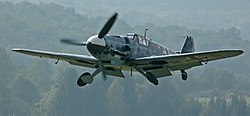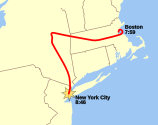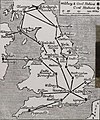Portal:Aviation
| Main page | Categories & Main topics |
|
Tasks and Projects |
The Aviation Portal

Aviation includes the activities surrounding mechanical flight and the aircraft industry. Aircraft includes fixed-wing and rotary-wing types, morphable wings, wing-less lifting bodies, as well as lighter-than-air craft such as hot air balloons and airships.
Aviation began in the 18th century with the development of the hot air balloon, an apparatus capable of atmospheric displacement through buoyancy. Some of the most significant advancements in aviation technology came with the controlled gliding flying of Otto Lilienthal in 1896; then a large step in significance came with the construction of the first powered airplane by the Wright brothers in the early 1900s. Since that time, aviation has been technologically revolutionized by the introduction of the jet which permitted a major form of transport throughout the world. (Full article...)
Selected article
The aircraft crashed into the North Tower of the World Trade Center at 08:46 local time; the impact killed all 92 people aboard, including the hijackers. Many people in the streets witnessed the collision, and Jules Naudet captured the impact on video. News agencies began to report on the incident soon after and speculated that the crash had been an accident. The impact and subsequent fire caused the North Tower to collapse, which resulted in thousands of additional casualties. During the recovery effort at the World Trade Center site, workers recovered and identified dozens of remains from Flight 11 victims, but many other body fragments could not be identified. (Full article...)
Selected image

Did you know
...that after the Red Baron, French ace René Fonck had the most confirmed World War I aerial victories? ...that the Ryan X-13 Vertijet aircraft landed by using a hook on its nose to hang itself on a wire? ... that Coast Aero Center and Norving were the first airlines with scheduled services at Geilo Airport, Dagali located in Hol, Norway?
General images -
In the news
- May 29: Austrian Airlines cancels Moscow-bound flight after Russia refuses a reroute outside Belarusian airspace
- August 8: Passenger flight crashes upon landing at Calicut airport in India
- June 4: Power firm helicopter strikes cables, crashes near Fairfield, California
- January 29: Former basketball player Kobe Bryant dies in helicopter crash, aged 41
- January 13: Iran admits downing Ukrainian jet, cites 'human error'
- January 10: Fire erupts in parking structure at Sola Airport, Norway
- October 27: US announces restrictions on flying to Cuba
- October 3: World War II era plane crashes in Connecticut, US, killing at least seven
- September 10: Nevada prop plane crash near Las Vegas leaves two dead, three injured
- August 6: French inventor Franky Zapata successfully crosses English Channel on jet-powered hoverboard
Related portals
Associated Wikimedia
The following Wikimedia Foundation sister projects provide more on this subject:
-
Commons
Free media repository -
Wikibooks
Free textbooks and manuals -
Wikidata
Free knowledge base -
Wikinews
Free-content news -
Wikiquote
Collection of quotations -
Wikisource
Free-content library -
Wikiversity
Free learning tools -
Wikivoyage
Free travel guide -
Wiktionary
Dictionary and thesaurus
Selected biography
During his formative years Trenchard struggled academically, failing many examinations and only just succeeding in meeting the minimum standard for commissioned service in the British Army. As a young infantry officer, Trenchard served in India and in South Africa. During the Boer War, Trenchard was critically wounded and as a result of his injury, he lost a lung, was partially paralysed and returned to Great Britain. While convalescing in Switzerland he took up bobsleighing and after a heavy crash, Trenchard found that his paralysis was gone and that he could walk unaided. Some months later, Trenchard returned to South Africa before volunteering for service in Nigeria. During his time in Nigeria, Trenchard commanded the Southern Nigeria Regiment for several years and was involved in efforts to bring the interior under settled British rule and quell inter-tribal violence.
In 1912, Trenchard learned to fly and was subsequently appointed as second in command of the Central Flying School. He held several senior positions in the Royal Flying Corps during World War I, serving as the commander of Royal Flying Corps in France from 1915 to 1917. In 1918, he briefly served as the first Chief of the Air Staff before taking up command of the Independent Air Force in France. Returning as Chief of the Air Staff under Winston Churchill in 1919, Trenchard spent the following decade securing the future of the Royal Air Force. He was Metropolitan Police Commissioner in the 1930s and a defender of the RAF in his later years.
Selected Aircraft

The Messerschmitt Bf 109 was a German World War II fighter aircraft designed by Willy Messerschmitt in the early 1930s. It was one of the first true modern fighters of the era, including such features as an all-metal monocoque construction, a closed canopy, and retractable landing gear. The Bf 109 was produced in greater quantities than any other fighter aircraft in history, with a total of 33,984 units produced up to April 1945. Fighter production totalled 47% of all German aircraft production, and the Bf 109 accounted for 57% of all German fighter types produced.
The Bf 109 was the backbone of the Luftwaffe fighter force in World War II, although it began to be partially replaced by the Focke-Wulf Fw 190 from 1941. The Bf 109 was the most successful fighter of World War II, shooting down more aircraft than any of its contemporaries. Originally conceived as an interceptor, it was later developed to fulfill multiple tasks, serving as bomber escort, fighter bomber, day-, night- all-weather fighter, bomber destroyer, ground-attack aircraft, and as reconnaissance aircraft.
The Bf 109 was flown by the three top-scoring fighter aces of World War II: Erich Hartmann, the top scoring fighter pilot of all time with 352 victories, Gerhard Barkhorn with 301 victories, and Günther Rall with 275 victories. All of them flew with Jagdgeschwader 52, a unit which exclusively flew the Bf 109 and was credited with over 10,000 victories, chiefly on the Eastern Front. Hartmann chose to fly the Bf 109 in combat throughout the war, despite being offered the use of the Me 262. Hans-Joachim Marseille, the highest scoring German ace in the North African Campaign, also scored all of his 158 victories flying the Bf 109, against Western Allied pilots.
- Span: 9.925 m (32 ft 6 in)
- Length: 8.95 m (29 ft 7 in)
- Height: 2.60 m (8 ft 2 in)
- Engine: 1× Daimler-Benz DB 605A-1 liquid-cooled inverted V12, 1,475 PS (1,455 hp, 1,085 kW)
- Cruising Speed: 590 km/h (365 mph) at 6,000 m (19,680 ft)
- First Flight: 28 May 1935
Today in Aviation
- 2009 – Pel-Air Westwind ditching or Norfolk Island ditching was an aircraft accident near Norfolk Island. A Westwind II jet operated by Pel-Air was conducting an air ambulance flight for CareFlight International when it was forced to ditch after being unable to land in bad weather and not having sufficient fuel to divert to an alternate destination.
- 2009 – Iran Air Fokker 100 EP-CFO suffered an undercarriage malfunction on take-off from Isfahan International Airport. The aircraft was on a flight to Mehrabad Airport, Tehran when the undercarriage failed to retract. The aircraft landed at Isfahan but was substantially damaged when the left main gear collapsed.
- 2009 – Virgin America commences service between their San Francisco (SFO) hub and Fort Lauderdale (FLL), as well as LAX-FLL.
- 2002 – American Airlines and British Airways announce plans to code-share some transatlantic flights, but the partnership is heavily restricted by US regulators.
- 1997 – The FBI concludes its investigation of the TWA Flight 800 crash, declaring there is no evidence of foul play. The NTSB’s investigation would continue.
- 1985 – The first Space Shuttle, Enterprise, is flown to Washington Dulles International Airport atop a Boeing 747 Shuttle Carrier Aircraft and transferred from the National Aeronautics and Space Administration to the Smithsonian Institution for eventual museum display. Although lacking engines and a heat shield and never having flown in space, it has been used for shuttle portability, gliding, vibration, and launch pad tests and on publicity tours.
- 1985 – Cessna is purchased by General Dynamics
- 1983 – (Aeroflot Flight 6833, a Tupolev Tu-134, is hijacked by seven Georgians attempting to defect from the Soviet Union; the aircraft is stormed by Alpha Group who arrest four hijackers; three are executed while the fourth receives a jail sentence; of the 71 on board (including the hijackers), eight die; the aircraft is written off.
- 1978 – First flight of the McDonnell Douglas F/A-18 Hornet
- 1975 – Boeing Wichita delivers its first modified B-52D to the Strategic Air Command.
- 1971 – Lockheed U-2A, 56-6952, Article 392, second airframe of the USAF supplementary production, delivered in January 1958, and assigned to the 4080th Strategic Reconnaissance Wing, Laughlin AFB, Texas. Converted to U-2C by November 1966. Assigned to training flights at Davis-Monthan AFB, Arizona, in 1969. Destroyed this date at Davis-Monthan, in a fatal landing accident. Pilot was Capt. John Cunney, who lands heavily, wing low, attempts go-around but stalls and crashes onto the runway.
- 1967 – First flight of the Dassault Mirage G
- 1966 – Captain William J. Knight flies the North American X-15 to a record speed of Mach 6.33 (4,250 mph, 6,840 km/h)
- 1964 – First flight of the Grumman C-2 Greyhound
- 1952 – Off northeastern Korea, three U. S. Navy F9 F-5 Panther fighters from Fighter Squadron 781 (VF-781) aboard the aircraft carrier USS Oriskany (CVA-34) engage seven MiG-15 s almost certainly flown by Soviet pilots, shooting down two MiG-15 s without loss to themselves.
- 1949 – A Douglas C-74 Globemaster carries 103 passengers and crew over the North Atlantic, the largest number to have made the crossing in a single flight.
- 1944 – First flight of the Mitsubishi Ki-83
- 1943 – Battle of Berlin (air), 440 Royal Air Force planes bomb Berlin causing only light damage and killing 131. The RAF lost nine aircraft and 53 air crew.
- 1943 – (18-19) Carrier aircraft from USS Essex (CV-9), USS Intrepid (CV-11), and USS Cabot (CVL-28) strike the island of Betio at Tarawa Atoll, inflicting considerable damage on Japanese forces there.
- 1943 – F/O DF McRae and crew, flying a Vickers Wellington of No. 179 (RAF) Squadron, sank the German submarine U-211.
- 1942 – First flight of the Tachikawa Ki-77.
- 1942 – In a typical wartime training accident, a Beechcraft AT-7 Navigator, 41-21079, c/n 1094, of the 341st School Squadron, crashes in the Mendel Glacier (one source says Darwin Glacier) in California’s Kings Canyon National Park. The four-member training flight left Mather Field in Sacramento, California, and was never heard from again. On 24 September 1947, a hiker discovered wreckage of the plane on a glacier in Kings Canyon. On 16 October 2005, a climber on the Mendel Glacier discovered a body believed to be one of the crew members. He was later identified as Leo M. Mustonen, 22, of Brainerd, Minnesota. The others were John M. Mortenson, 25, of Moscow, Idaho; William R. Gamber, 23, of Fayette, Ohio; and Ernest G. Munn of St. Clairsville, Ohio. A second body was found under receding snow in 2007 and was identified Ernest G. Munn.
- 1941 – No. 416 (Fighter) Squadron was formed in England.
- 1938 – The Battle of the Ebro ends with Spanish Nationalists retaking all territory captured by the Republicans. The Spanish Republican Air Force has lost between 150 and 170 aircraft since the battle began on July 25, and the Nationalists also have lost many planes.
- 1930 – First flight of the Boeing XP-9
- 1923 – The first aerial refueling-related fatality occurs during an air show at Kelly Field, Texas, when the fuel hose becomes entangled in the right wings of the refueler and the receiver aircraft. The Army Air Service pilot of the refueler, Lt. P. T. Wagner, is killed in the ensuing crash of DH-4B, 23-444.
- 1923 – Alan Shepard (Rear Admiral, USN, Ret.), American astronaut, was born (d. 1998). Shepard was the first American in space. He later commanded the Apollo 14 mission, and was the fifth person to walk on the moon.
- 1922 – First flight of the Dewoitine D.1
- 1911 – First British seaplane to leave the water, and the first seaplane to take off from British waters, an Avro Type D, the first of six of the type, piloted by Royal Navy Commander Oliver Schwann, lifts off from Cavendish Dock, Barrow-in-Furness, England briefly, falls back into the water and is damaged. His lack of training betrayed him, and the first take-off was not followed by the first successful landing. The Avro will be repaired.
References
- Shortcuts to this page: Portal:Airplanes • P:AVIA





















































